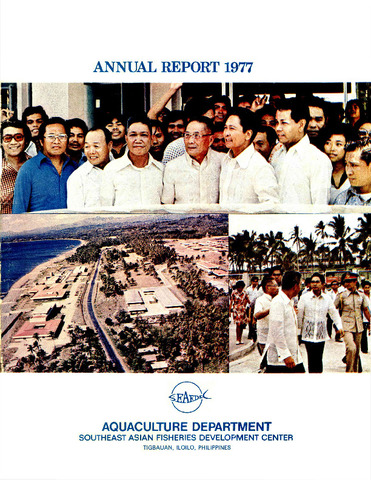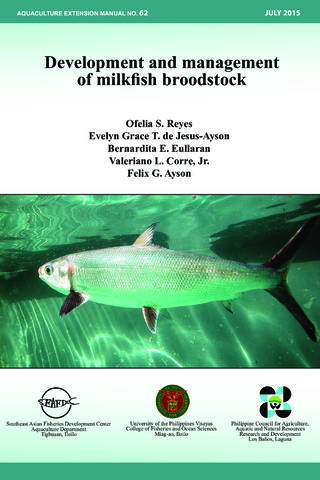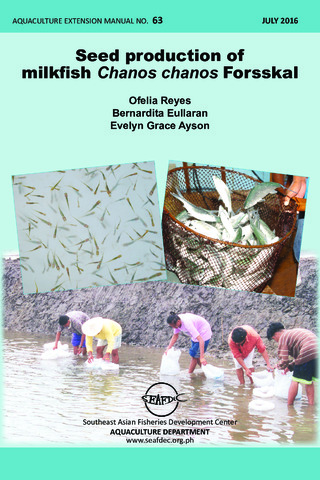| dc.contributor.author | Villegas, Cesar T. | |
| dc.contributor.author | Millamena, Oseni | |
| dc.contributor.author | Escritor, F. | |
| dc.date.accessioned | 2013-01-22T06:57:30Z | |
| dc.date.available | 2013-01-22T06:57:30Z | |
| dc.date.issued | 1990 | |
| dc.identifier.citation | Villegas, C. T., Millamena, O., & Escritor, F. (1990). Food value of Brachionus plicatilis fed three selected algal species as live food for milkfish, Chanos chanos Forsskal, fry production. Aquaculture and Fisheries Management, 21(2), 213–220. | en |
| dc.identifier.issn | 0266-996X | |
| dc.identifier.uri | http://hdl.handle.net/10862/1327 | |
| dc.description | Villegas, C. T., Millamena, O., & Escritor, F. (1990). Food value of Brachionus plicatilis fed three selected algal species as live food for milkfish, Chanos chanos Forsskal, fry production. Aquaculture Research, 21(2), 213–220. (new journal title) | |
| dc.description.abstract | The effects of three selected algal species, Tetraselmis tetrahele, Isochrysis galbana and marine Chlorella sp. on the population growth of Brachionus plicatilis was evaluated after 3, 5 and 7 days of culture. The rotifers fed on T. tetrahele showed superior growth with mean peak density of 92.5 individuals per ml to those fed on I. galbana (48.2 individuals per ml) and Chlorella sp. (47.2 individuals per ml) in 5 days.
In another experiment, milkfish. Chanos chanos Forsskal, fry with initial mean body weight and standard length of 6.26 ± 1.07mg and 13.04 ± 1.40mm, respectively, were fed B. plicatilis reared on the three algal species for 30 days. Results showed that growth, measured in terms of gain in weight and length, was significantly different (P > 0.05) among treatments. Fastest growth was obtained in fry fed B. plicatilis cultured on T. tetrahele with mean gains in weight and length of 61.48 ± 8.40mg and 9.37 ± 1.68 mm, respectively, followed by fry fed B. plicatilis reared on I. galbana (43.56 ± 8.35mg and 6.25 ± 0.48mm). Milkfish fry fed B. plicatilis cultured on Chlorella sp. gave the poorest growth with mean gains in weight and length of 11.05 ± 1.82mg and 2.33 ± 0.29mm, respectively. Percentage survival ranged from 93.1 to 95.3 percent and was not significantly different between treatments (P < 0.05).
The differences in population growth of B. plicatilis and consequently growth of milkfish fry was almost certainly attributed to the differences observed in the biological values of their algal diet, and in particular their protein and lipid contents. T. tetrahele and I. galbana improved the food value of B. plicatilis as live food for the milkfish fry. Their high dietary value was related to the higher algal protein and fat levels and contents of n-3 HUFA particularly 20:5n-3 and 22:6n-3 compared to B. plicatilis cultured on Chlorella sp. The results of the present study point to T. tetrahele as the most suitable food for the mass culture of the rotifer, B. plicatilis. | en |
| dc.language.iso | en | en |
| dc.publisher | Blackwell Publishing | en |
| dc.subject | Brachionus plicatilis | |
| dc.subject | Chanos chanos | |
| dc.subject | Chlorella | |
| dc.subject | Isochrysis galbana | |
| dc.subject | Tetraselmis tetrahele | |
| dc.title | Food value of Brachionus plicatilis fed three selected algal species as live food for milkfish, Chanos chanos Forsskal, fry production | en |
| dc.type | Article | en |
| dc.citation.volume | 21 | |
| dc.citation.issue | 2 | |
| dc.citation.spage | 213 | |
| dc.citation.epage | 219 | |
| dc.citation.journalTitle | Aquaculture and Fisheries Management | en |
| dc.subject.asfa | fish culture | en |
| dc.subject.asfa | fry | en |
| dc.subject.asfa | growth | en |
| dc.subject.asfa | nutritive value | en |
| dc.subject.asfa | live feeds | en |
| dc.identifier.doi | 10.1111/j.1365-2109.1990.tb00458.x | |
| dc.subject.scientificName | Chanos chanos | |



